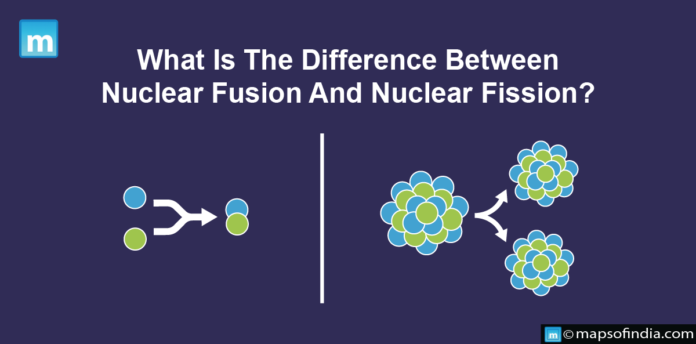Nuclear fusion and fission are two types of nuclear reactions that involve the release of energy from atomic nuclei. While both reactions involve splitting or combining atomic nuclei, they differ in their underlying mechanisms and energy yields. The article discusses nuclear fusion and fission, provides examples, and compares their differences.
Nuclear Fusion
Nuclear fusion is the mechanism through which atomic nuclei unite to generate a heavier nucleus while emitting energy. This reaction is the process by which stars, including our sun, produce energy. In nuclear fusion, the total mass of the reactants is greater than the mass of the products, and the difference in mass is converted into energy according to Einstein’s famous equation, E=mc^2. For nuclear fusion to occur, atomic nuclei must be brought together at high temperatures and pressures to overcome the repulsive forces between the positively charged nuclei. This process requires a lot of energy, and achieving sustained fusion reactions on Earth is currently difficult.
Example of Nuclear Fusion
One example of nuclear fusion is the reaction in the sun, where hydrogen atoms fuse to form helium. The reaction releases a lot of energy, which allows the sun to shine.
Nuclear Fission
Nuclear fission is when atomic nuclei are split apart, releasing energy. This reaction is the process by which nuclear power plants produce energy. In nuclear fission, the total mass of the reactants is greater than the mass of the products, and the difference in mass is converted into energy. For nuclear fission to occur, atomic nuclei must be bombarded with neutrons, which causes them to become unstable and split apart, releasing energy in the process. Nuclear fission products are typically radioactive and can be harmful to living organisms.
Example of Nuclear Fission
One example of nuclear fission is the reaction in nuclear power plants, where uranium-235 atoms are bombarded with neutrons, causing them to split apart and release energy in the form of heat.
Comparison between Nuclear Fusion and Fission:
- Mechanism: Nuclear fusion involves the combination of atomic nuclei, while nuclear fission involves the splitting of atomic nuclei.
- Energy Yield: Nuclear fusion has a higher energy yield than nuclear fission. Fusion releases more energy per unit mass of fuel than fission, making it a potentially more efficient energy source.
- Fuel: Nuclear fusion uses light elements such as hydrogen, while nuclear fission uses heavy elements such as uranium.
- Waste: Nuclear fusion produces very little radioactive waste, while nuclear fission produces much waste that must be safely stored and disposed of.
- Safety: Nuclear fusion is believed to be safer than nuclear fission because it does not generate the same amount of radioactive material or have the possibility for a nuclear meltdown.
Note: Nuclear fusion can be more effective and safer than nuclear fission, but it is presently challenging to generate on a large scale. It will require considerable technological improvements before it can be considered a viable energy source.





